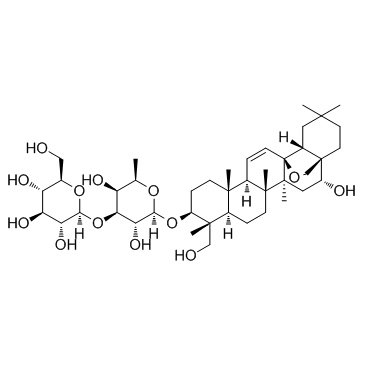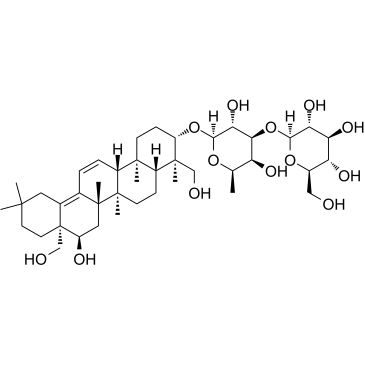| Description |
Saikosaponin D is a triterpene saponin isolated from Bupleurum, with anti-inflammatory, anti-bacterial, anti-tumor, and anti-allergic activities; Saikosaponin D inhibits selectin, STAT3 and NF-kB and activates estrogen receptor-β.
|
| Related Catalog |
|
| Target |
STAT3
NF-κB
ERβ
|
| In Vitro |
Saikosaponin D (Compound 3) is a triterpene saponin, which inhibits E-selectin, L-selectin and P-selectin binding to THP-1 cells, with IC50s of 1.8 µM, 3.0 µM and 4.3 µM, and such effects are not due to cytotoxic action. Saikosaponin D (1, 5, 10 µM) dose-dependently inhibits the THP-1 adhesion to the HUVECs monolayer activated by TNF-α. Saikosaponin D (30 μM) also inhibits the expression of P-selectin ligand (CD162) in THP-1 cells[1]. Saikosaponin D (5 μM) suppresses the proliferation of HSC-T6 cells induced by H2O2 treatment, reduces the expression levels of α-SMA, TGF-β1, Hyp, COL1 and TIMP-1, and increases MMP-1 expressioon, thus inhibiting H2O2-induced excessive extracellular matrix (ECM) formation, with similar effects to estradiol (E2), and these effects are blocked by ER antagonists. Saikosaponin D also inhibits oxidative stress-induced ROS generation and down reduates MAPK signaling pathway, and the inhibition is also suppressed by ER antagonists[3].
|
| In Vivo |
Saikosaponin D (2 mg/kg/day, i.p.) shows a protective effect on overdose of acetaminophen (APAP)-induced liver injury of mice. Saikosaponin D affects APAP metabolism, increases GSH levels but does not alter PPARα activation. Saikosaponin D (2 mg/kg/day, i.p.) also suppresses APAP-induced increases in the expression of STAT3 target genes and pro-inflammatory cytokines and inhibits APAP-induced activation of STAT3 and NF-kB[2].
|
| Cell Assay |
Cell viability is assessed by morphology and by reduction of the tetrazolium salt (MTT). Briefly, the THP-1 cells (2 × 105 cells/well) and various concentrations of compounds 1-4 (including Saikosaponin D) are added to the 96-well plates, incubated for 48 h at 37°C, and 5 µL of MTT solution (5 mg/mL in PBS) is added to each well of the 96-well plates. After incubation for 4 h at 37°C, the absorbance is measured at 540 nm using a microplate reader with the reference absorbance at 650 nm[1].
|
| Animal Admin |
Mice[2] Male 6- to 7-week-old C57BL6 mice are randomly divided into four groups, vehicle/control, Saikosaponin D (SSd)/control, vehicle/APAP, and SSd/APAP, and killed 4 h or 24 h after single APAP injection. For overdose of acetaminophen (APAP) injection, a typical single dose of 200 mg/kg/day is used. Saikosaponin D, 2 mg/kg once daily is used as the dosing regimen. Saikosaponin D powder is dissolved in a saline solution supplemented with 0.1% Tween 20 and is administered by intraperitoneal injection at a dose of 2 mg/kg/day once daily for five days. Saline solution containing 0.1% Tween 20 without Saikosaponin D is administered as a vehicle. APAP is dissolved in warm saline solution (20 mg/mL) and is injected intraperitoneally 30 minutes after the last Saikosaponin D injection. Saline is injected to mice in the control groups[2].
|
| References |
[1]. Jang MJ, et al. Saikosaponin D isolated from Bupleurum falcatum inhibits selectin-mediated cell adhesion. Molecules. 2014 Dec 4;19(12):20340-9. [2]. Liu A, et al. Saikosaponin d protects against acetaminophen-induced hepatotoxicity by inhibiting NF-κB and STAT3 signaling. Chem Biol Interact. 2014 Nov 5;223:80-6. [3]. Que R, et al. Estrogen receptor-β-dependent effects of saikosaponin‑d on the suppression of oxidative stress-induced rat hepatic stellate cell activation. Int J Mol Med. 2018 Mar;41(3):1357-1364.
|

 CAS#:58316-41-9
CAS#:58316-41-9
